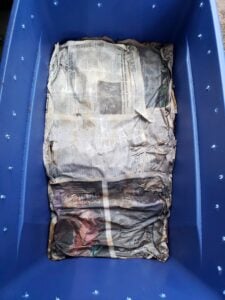
How to Make a Worm Compost Bin (Worm Farm)
Vermicomposting, or composting with worms, is easy, fun, and sustainable! Read along to learn how to set up and maintain a simple worm compost bin at home, including tips on how to feed a worm bin.
Equipment
- A simple bin with a solid lid, such as a large durable plastic storage tote. 20-50 gallons recommended, durable/heavy duty and not transparent
- Dry bedding material, such as shredded newspaper, coco coir, dry leaves, grass clippings, shredded cardboard, brown paper bags, or straw. enough to fill about the bottom 1/4 of the bin
- Compost worms. I start with 1,000-2,000 worms (one to two pounds) for a 35 gallon worm bin
- Grit or dirt just a few handfuls
- Food or garden scraps
- Recommended: a drill and 1/4" bit to add air holes to the bin
Instructions
Making a New Worm Bin
- Add a couple dozen small air holes to the side walls of the bin near the top. We use a 1/4" drill bit. Do NOT add "drainage" holes to the bottom.

- Fill the bottom quarter of the bin with brown/dry bedding material of choice. We like to use a mix of shredded newspaper and coco coir - which comes in brick form and needs to be rehydrated and fluffed first. Use about 5 pounds of coco coir bricks for a 35 gallon bin. (Don't overwet the coir, damp is good - not soggy)

- Lightly moisten the bedding in the worm bin. Worms like damp environments, but not sopping wet - they breathe through their skin and can drown! Too wet of a worm bin also makes it stink.

- Add compost worms. Dig a hole in the bedding, add the worms, then bury them.

- Tip: the worms may try to escape the bin at first. Cover the material in the bin with a layer of damp newspaper or brown paper bags to help keep them in, and check the bin every day or two. Collect worms that have gathered around the lid or walls and put them back inside the bedding.

- Add a small amount of food right away. See "yes" and "no" list for food and routine feeding tips below.

Feeding a Worm Bin
- Each time you feed the worm bin, dig a small hole and bury the food by at least a couple inches of bedding.

- Good food for worm bins include most fruit and vegetable scraps, crushed eggshells, spent coffee grounds, loose leaf tea or paper tea bags (staple removed) and tender garden trimmings. Avoid dairy, meat, processed or moldy/rotten foods, citrus (too acidic) or animal manure, and limit starchy foods, grains or bread.

- Under ideal conditions, worms can eat their body weight in a day (so 1 pound of worms can eat 1 pound of food waste). Yet they slow down during cool conditions, so err on the conservative side. We prefer to feed our worm bin weekly. You'll learn with time how much your worms can eat in a week. If you add too much food before they can eat it, it will rot and stink.

- Before adding food each week, carefully stir and fluff all of the contents of the worm bin to introduce air, assess how much food they’ve eaten since last week, and generally check the condition of the bin.

- In an established worm farm, it is best practice to add a handful of “browns” (bedding) each time you add more food scraps, or at least once every other week.
- Cutting or breaking up large chunks of food will help the worms break it down faster.
- See the full written blogpost for more ongoing maintenance tips, including how to keep your bin the right moisture level, and how to protect it during extreme heat or freezing.
Notes
Note that temperatures below 35F or above 95F (internal bin temperature) can kill compost worms. See the written blogpost for tips on how to keep a worm bin cool or warm. Suggestions include (not limited to): moving it indoors or to a more protected location, keeping it in the shade, wrapping it with wool blankets, using deep mulch inside the bin for insulation, adding frozen water bottles to keep it cool, and more.
Tried this recipe?Let us know how it was!